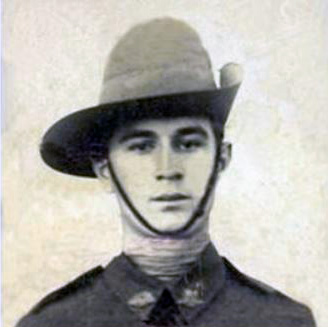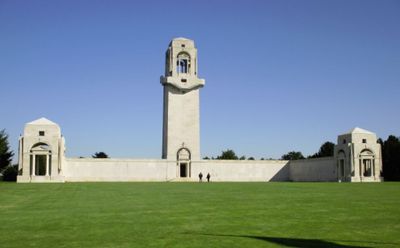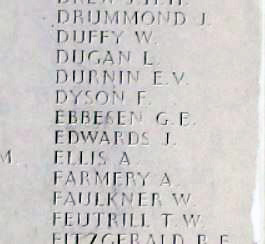Francis Dyson
From Our Contribution
 Courtesy National Archives - Discovering ANZACs | |
| Personal Information | |
|---|---|
| Date of Birth | Not known |
| Place of Birth | Liverpool, England |
| Death | 15 Apr 1917 |
| Place of Death | Lagnicourt, France |
| Age at Enlistment | 18 years, 9 months |
| Description |
5'7" (1.70m) tall ; 125lbs 56.699 kg ; fresh complexion ; brown eyes ; brown hair |
| Occupation | Labourer |
| Religion | Roman Catholic |
| Address | William street, East Cannington, Western Australia |
| Next of Kin | Father , Mr. Frank Dyson |
| Military Information | |
| Reg Number | 5690 |
| Date of Enlistment | 13 Mar 1916 |
| Rank | Private |
| Unit/Formation | 11th Battalion, 18th Reinforcement, allocated to A Company |
| Date of Embarkation | 6 Jun 1916 ‒ 21 Jul 1916 |
| Ship Embarked On | HMAT A29 Suevic |
| Fate | Killed in action 15 Apr 1917 Lagnicourt, France |
| Monument |
none locally at present Villers-Bretonneux Memorial Australian War Memorial |
| Medals |
British War Medal Victory Medal |
Contents
Pre War
Arrived in Australia aged 16.
War Service
Entered camp on 13 Mar 1916, and on 4 Apr 1916 he was allocated to the 18th Reinforcement draft for the 11th Battalion with whom he travelled to England, travelling on HMAT A29 Suevic. Disembarking at Plymouth on 21 Jul 1916 he was sent to the 3rd Training Battalion before proceeding overseas to France from Perham Downs on 5 Sep 1916. After being held in the Base Depot for 10 days receiving additional trench related training, he joined his battalion on 17 Sep 1916 in the Railway Dug outs south of Ypres.
On 30 Jan 1917 Francis was seen by the [13th Field Ambulance]] who diagnosed Otitis Media (inflammation of the middle ear) and sent him to the rear via a Casualty Clearing Station and an Ambulance Train to the 2nd General Hospital at Le Havre where he was admitted on 1 Feb 1917. Discharged to duty on 22 Feb 1917, he was back with the 11th Battalion on 6 Mar 1917. On 14 Apr 1917 the 11th Battalion was in the line near Lagnicourt, holding it in less strength than was usual due to the heavy Australian losses suffered in the 1st Bullecourt battle on 11 Apr 1917. The Germans noticed this decrease in strength and decided to attack them. On the 14th the battalion had two of their outposts that were manned by 'A' Company attacked and captured by the Germans, and the rest were heavily shelled throughout the day.
At 4:00am the following day (15th) the Germans initiated a 15 minute duration artillery attack on the 11th Battalion's positions, followed by an infantry attack. The attack was heaviest in the area held by 'A' Company. The enemy forced several elements of the battalion back to pre determined fall back positions before the Australians were able to successfully counter attack. The enemy were said to have suffered heavy casualties, more than matching the heavy casualties of the 11th Battalion. Enemy strength was 16,000 compared to the Australian's force of 4,000, and German casualties were officially two for every Australian. Both sides had 300 men captured by their respective enemy that day.
I can find no record as to how Francis was killed, only that the date of his death is given as 15 Apr 1917. The fact that the Australians recovered their ground, and that he has no known grave indicates that he may have been a casualty of artillery action.
Notes
Not on the Canning Honour Roll

